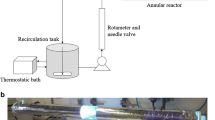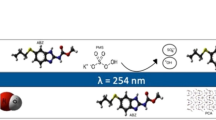Abstract
A dynamic kinetic model is presented for the UVC/H2O2-driven process. The model comprises 103 reactions, including background species, such as HCO3–/CO32–, NO2–, NO3–, SO42−, Cl−, and H2PO4−/HPO42/PO43– anions, and effluent organic matter (EfOM) was validated based on experimental data obtained for the photooxidation of the nonribosomal peptide antibiotic zinc bacitracin (Zn-Bc, 34 μmol L−1). The set of ordinary differential equations for 38 species was combined with the molar balances describing the recirculating tubular photoreactor used. Predictions for the photolytic and UVC/H2O2 processes confirmed the good agreement with experimental data, enabling the estimation of fundamental kinetic parameters, such as the direct photolysis quantum yield (Ф254 nm, Zn-Bc = 0.0143 mol Einstein−1) and the second-order rate constants for the reactions of Zn-Bc with HO•, HO2•, and O2•− radicals (2.64 × 109, 1.63 × 103, and 1.49 × 104 L mol−1 s−1, respectively). The predicted optimum process conditions correspond to [H2O2]0 = 6.8 mmol L−1 and a specific photon emission rate of 11.1 × 10−6 Einstein L−1 s−1. Zn-Bc photooxidation was significantly impacted by wastewater constituents, particularly EfOM and HCO3–/CO32– (i.e., alkalinity), resulting in a degradation rate about 32% lower compared to that obtained in deionized water. In particular, EfOM acts as a strong radical scavenger and inner filter. In addition, simulations pointed out the continuous tubular photochemical reactor as the best configuration for treating Zn-Bc-containing wastewater. This study hence provides a comprehensive modeling approach, especially useful for predicting the effect of complex water matrices on the performance of the UVC/H2O2 treatment process.










Similar content being viewed by others
Data availability
All data generated or analyzed during this study are included in this published article.
Abbreviations
- AOT:
-
advanced oxidation technologies
- CSTR:
-
continuous stirred-tank reactor
- EfOM:
-
wastewater effluent organic matter
- FVM:
-
finite volume method
- NRP:
-
nonribosomal peptides
- ODE:
-
ordinary differential equation
- PFR:
-
plug flow reactor
- PROD1:
-
dissolved organic products generated from Zn-Bc degradation
- PROD2:
-
dissolved organic products generated from EfOM degradation
- RTD:
-
residence time distribution
- SUVA:
-
specific UV absorption
- TOC:
-
total organic carbon
- UVC:
-
ultraviolet radiation (254 nm)
- WWTP:
-
wastewater treatment plant
- Zn-Bc:
-
zinc bacitracin
- Abs254 nm :
-
total absorbance of the solution at 254 nm
- [C]:
-
molar concentration of the species C (mol L−1)
- [C]0 :
-
initial molar concentration of the species C (mol L−1)
- E P,0 :
-
specific photon emission rate (μmol photons L−1 s−1)
- k :
-
reaction rate constant (L mol−1 s−1 or s−1)
- ka:
-
acid-base equilibrium constant
- k global :
-
global reaction rate constant (s−1)
- k Zn-Bc, HO • :
-
second-order reaction rate constant of Zn-Bc with hydroxyl radical (L mol−1 s−1)
- \( {k}_{\mathrm{Zn}-\mathrm{Bc},\kern0.75em \mathrm{H}{\mathrm{O}}_2^{\bullet }} \) :
-
second-order reaction rate constant of Zn-Bc with hydroperoxyl radical (L mol−1 s−1)
- \( {k}_{\mathrm{Zn}-\mathrm{Bc},\kern0.75em {\mathrm{O}}_2^{\bullet -}} \) :
-
second-order reaction rate constants of Zn-Bc with superoxide radical anion (L mol−1 s−1)
- l reactor :
-
reactor path length (m)
- n :
-
number of the compartment where the reaction occurs: 1 (CSTR 2) and 2 (PFR)
- r :
-
reaction rate term (mol L−1 s−1)
- t :
-
time (s)
- UVA254 :
-
decadic UV absorption coefficient at 254 nm (cm−1)
- UVA310 :
-
decadic UV absorption coefficient at 310 nm (cm−1)
- V :
-
volume (L)
- V T :
-
volume of the recirculating tank (L)
- V r :
-
volume of the annular tubular photoreactor (L)
- v :
-
flow rate (L s−1)
- ε :
-
molar absorption coefficient (L mol−1 m−1)
- Ф :
-
photolysis quantum yield (mol Einstein−1)
- τ :
-
residence time (s)
- ε :
-
molar absorption coefficient (L mol−1 m−1)
- Ф :
-
photolysis quantum yield (mol Einstein−1)
- τ :
-
residence time (s)
References
Audenaert WTM, Vermeersch Y, Van Hulle SWH, Dejans P, Dumoulin A, Nopens I (2011) Application of a mechanistic UV/hydrogen peroxide model at full-scale: sensitivity analysis, calibration and performance evaluation. Commun Agric Appl Biol Sci 76:181–184
Bielski HJ, Benon HJ, Cabelli DE, Ravindra LA, Alberta AB (1985) Reactivity of HO2/O2– radicals in aqueous solution. J Phys Chem Ref Data 14:1041–1100
Braun AM, Maurette MT, Oliveros E (1991) Photochemical technology. John Wiley & Sons, Chichester
Buxton GV, Greenstock CL, Helman WP, Ross AB (1988) Critical review of rate constants for reactions of hydrated electrons, hydrogen atoms and hydroxyl radicals (•OH/•O–) in aqueous solution. J Phys Chem Ref Data 17:513–886
Canonica S, Kohn T, Mac M, Real FJ, Wirz J, Von Gunten U (2005) Photosensitizer method to determine rate constants for the reaction of carbonate radical with organic compounds. Environ Sci Technol 39:9182–9188
Chang M, Chung C, Chern J, Chen T (2010) Dye decomposition kinetics by UV/H2O2: initial rate analysis by effective kinetic modeling methodology. Chem Eng Sci 65:135–140
Crittenden JC, Shumin H, Hand DW, Green SA (1999) A kinetic model for H2O2/UV process in a completely mixed batch reactor. Water Res 33:2315–2328
De Laat J, Le GT, Legube B (2004) A comparative study of the effects of chloride, sulfate and nitrate ions on the rates of decomposition of H2O2 and organic compounds by Fe(II)/H2O2 and Fe(III)/H2O2. Chemosphere 55:715–723
Edalatmanesh M, Dhib R, Mehrvar M (2008) Kinetic modeling of aqueous phenol degradation by UV/H2O2 process. Int J Chem Kinet 40:34–43
Glaze WH, Lay Y, Kang JW (1995) Advanced oxidation processes. A kinetic model for the oxidation of 1,2-dibromo-3-chloropropane in water by the combination of hydrogen peroxide and UV radiation. Ind Eng Chem Res 34:2314–2323
Grenni P, Ancona V, Caracciolo AB (2018) Ecological effects of antibiotics on natural ecosystems: a review. Microchem J 136:25–39
Liao C, Gurol M (1995) Chemical oxidation by photolytic decomposition of hydrogen peroxide. Environ Sci Technol 29:3007–3014
Lofrano G, Pedrazzan R, Libralato G, Carotenuto M (2017) Advanced oxidation processes for antibiotics removal: a review. Curr Org Chem 21:1054–1067
Lundeen RA, Chu C, Sander M, Mcneill K (2016) Photooxidation of the antimicrobial, nonribosomal peptide bacitracin A by singlet oxygen under environmentally relevant conditions. Environ Sci Technol 50:8586–8595
Luo C, Jiang J, Ma J, Pang S, Yongze L, Song Y, Guan LJ, Jin Y, Wu D (2016) Oxidation of the odorous compound 2,4,6-trichloroanisole by UV activated persulfate: Kinetics, products, and pathways. Water Res 96:12–21
Mariani ML, Romero RL, Zalazar CS (2015) Modeling of degradation kinetic and toxicity evaluation of herbicides mixtures in water using the UV/H2O2 process. Photochem Photobiol Sci 14:608–617
Metolina P, Lourenço FR, Teixeira ACSC (2020) UVC- and UVC/H2O2-driven nonribosomal peptide antibiotics degradation: application to zinc bacitracin as a complex emerging contaminant. J Environ Sci Health A DOI:1–16. https://doi.org/10.1080/10934529.2020.1841499
Neta P, Huie RE, Ross AB (1988) Rate constants for reactions of inorganic radicals in aqueous solution. J Phys Chem Ref Data 17:1027–1284
Pavli V, Kmetec V (2006) Pathways of chemical degradation of polypeptide antibiotic bacitracin. Biol Pharm Bull 29:2160–2167
Peres JCG, de Silvio U, Teixeira ACSC, Guardani R, Vianna AS Jr (2015) Study of an annular photoreactor with tangential inlet and outlet: I. Fluid dynamics. Chem Eng Technol 38:311–318
Perry RH, Green DW, Maloney JD (1981) Chemical engineer’s handbook. McGraw-Hill, New York
Rubio-Clemente A, Chica E, Penuela GA (2017) Kinetic model describing the UV/H2O2 photodegradation of phenol from water. Chem Ind Chem Eng Q 23:547–562
Song W, Ravindran V, Pirbazari M (2008) Process optimization using a kinetic model for the ultraviolet radiation-hydrogen peroxide decomposition of natural and synthetic organic compounds in groundwater. Chem Eng Sci 63:3249–3270
Stumm W, Morgan JJ (1996) Aquatic chemistry, chemical equilibria and rates in natural waters. Wiley, New York
Versteeg HK, Malalasekera W (1995) An introduction to computational fluid dynamics: the finite volume method. Pearson, Harlow
Westerhoff P, Aiken G, Amy G, DebrouxJ (1999) Relationships between the structure of natural organic matter and its reactivity towards molecular ozone and hydroxyl radicals. Water Res 33:2265–2276
Wols BA, Harmsen DJH, Beerendonk EF, Hofman-Caris CHM (2014) Predicting pharmaceutical degradation by UV (LP)/H2O2 processes: a kinetic model. Chem Eng J 255:334–343
Funding
This study was funded by the Coordenação de Aperfeiçoamento de Pessoal de Nível Superior – Brasil (CAPES) - Finance Code 001 and National Council for Scientific and Technological Development (CNPq) (grant # 131210/2016-5).
Author information
Authors and Affiliations
Contributions
P.M.: conceptualization, formal analysis, investigation, methodology, software, validation, visualization, writing—original draft, writing—review and editing. A.C.S.C.T.: conceptualization, formal analysis, validation, resources, writing—original draft, writing—review and editing, supervision, funding acquisition. All authors read and approved the final manuscript.
Corresponding author
Ethics declarations
Ethics approval and consent to participate
Not applicable.
Consent for publication
Not applicable.
Conflict of interest
The authors declare that they have no conflict of interest.
Additional information
Responsible Editor: Vítor Pais Vilar
Publisher’s note
Springer Nature remains neutral with regard to jurisdictional claims in published maps and institutional affiliations.
Supplementary information
ESM 1
(DOCX 128 kb)
Rights and permissions
About this article
Cite this article
Metolina, P., Teixeira, A.C.S.C. A comprehensive dynamic kinetic model for the UVC/H2O2 process: application to zinc bacitracin degradation in wastewater as a case study. Environ Sci Pollut Res 28, 24150–24166 (2021). https://doi.org/10.1007/s11356-021-12437-4
Received:
Accepted:
Published:
Issue Date:
DOI: https://doi.org/10.1007/s11356-021-12437-4




